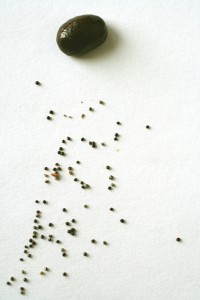Epazote in a Vermont Garden

Epazote in the garden at Dowdy Corners, planted in and among the arugula
A couple of books ago, Dowdy Corners Cookbook Club was thick in the middle of Mexican cooking, and it was my chance to find out what the herb epazote is all about. It’s usually described as being quintessential to the cooking of Mexico and as having a distinctive and pungent flavor so unique that no other herb will do; recipe writers eschew substitutions of any kind, saying it’s better to omit, if you don’t have it.
If you don’t live in an area with markets that cater to Mexicans, the only opportunity you’ll have to try it, particularly when fresh, is to grow it yourself. So, against all odds of having something leafy and green to work with before the club moved on to the next book, I ordered epazote seeds in February, when we started cooking from The Art of Mexican Cooking, planted them in seed starter pots, and stuck then in my window sill. After undergoing an intermediary transplanting to to-go soup containers, and then, much later, several days of “hardening off,” the plants were ready, in late May, when all danger of frost had past, to be moved to the garden.

Miniscule epazote seeds with a coffee bean for scale

Epazote at day 10

Epazote at 10 weeks
Epazote, also called wormseed or Mexican tea (it is used as a tea, thus the name), is an herbal remedy and an antiflatulent, making it a popular addition to bean dishes, and in particular black beans. (Dianna Kennedy describes the herb as a sine qua non for the cooking of black beans.)
To discover what epazote brings to the bean pot, I made a very simple recipe called Oaxacan Black Beans in The Art of Mexican Cooking made with just water, onion, garlic, epazote, and salt. The salt and epazote are added once the beans are tender, and then cooked for an additional 30 minutes. At the point when the beans were tender, I removed a portion and added salt to taste only, so that I could compare the beans with and without epazote.
I was amazed by the difference between the two batches. The epazote brought the beans to life. The beans without the epazote tasted bland by comparison, and reminded me why I generally like beans cooked with bits of smoky pork product to add depth of flavor. You can’t identify the specific flavor of epazote in the beans, but it gives them more dimension—it simply makes them yummier. I urge every vegetarian, limited to meat-free beans, to add epazote to their bean pots. With the addition of just one herb, you get so much.
When raw, epazote does indeed have a strong aroma and flavor. Some liken the smell to kerosene or gas. The taste reminded me of mint and camphor on steroids with a hot astringent note, leaving your mouth feeling a bit tingly—memories of Vick’s VapoRub came to mind. But when cooked in food, epazote gives up its flavor completely, transforming beans in the process.
Most food writers say not to bother with the dried version, as it loses too much of its character. My two-week-old dried epazote did lose some of its aroma and flavor, but not all. So if dried is all that you can find, it may still be worth trying.
If you’ve planted epazote, don’t dig it up in the fall. It self-seeds and returns in the spring in warmer climates. In Vermont, it should not come back, but I’m going to leave it, just to see.

From all of those tiny seeds of maybe 3 plants last summer, I have one volunteer this summer, that is just now forming seeds. I forgot that I dried a bunch of seeds last fall and could have planted them. The seeds are hard to come by.
1You are the only other person I know, Holly, locally, who has taken the time to explore the possibilities of epazote. Now, proportions, please. How many teaspoons(?) to say two cups of dried beans?
So it will come back? It will? It will? That’s very exciting. Then my epozaote and arugula will be fighting it out for space next spring (they share the same bed). Arugula is something that has come back in my garden–surprisingly. I’m not at home right now, so I’ll have to get back with you about the amount of epazote to beans. I do recall that Diana Kennedy did call for puting the entire stem with leaves in the bean pot.
2Here you are Sharon: 1 pound black beans to 2 large leafy stems of epazote.
3Holly, Dear heart, Brooke sent a request from her school to purchase a magazine. The one I chose from the list provided is “Eating Well”. I will have to watch for the comparisons of the 3 chosen magazines for the month. What a good idea. I wonder how different your garden fresh Arugala tastes in comparison to that which I can purchase from “Publix” here in Florida. I sure would like a handful of yours. Beautiful photo – very alive with positive vibrations. LJH
4Anyone still have any epazote seedss? Could you please email me? Thanks in advance…..
5I don’t seem to have my old seed packet any longer, and to be honest I can’t remember where exactly I purchased my seeds. But Johnny Seeds sells them, and I’ve always had good luck with their seeds: http://www.johnnyseeds.com/p-8203-epazote-og.aspx
6